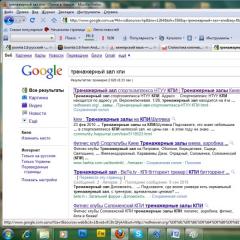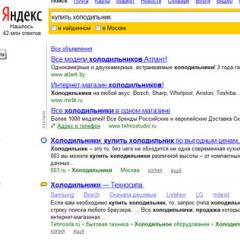Modeling business processes. Module "Business Processes" Documenting the new design of a business process
Business Process Designer is a tool for manual or automatic execution of sequentially composed Tasks.
For example, the standard module allows you to specify only one set of conditions to filter the records for which the business process will be run. IN Business Process Designer there is a Condition task that allows you to specify a different way of processing different types of records. You can use the Condition task any number of times! Among other things, this allows you to handle errors (for example, there are no associated transactions with the Counterparty).
Each Task has one input and one or more outputs. Handler starts with a task Start and executes one Task after another step by step in the specified order until the execution path ends at the last Task. You can connect the output of one task to the inputs of two tasks and split the flow of execution into two parts.
Business Process Designer has built-in debugging tools! You can track which way the business process went, what the SMTP server returned when you sent the letter, collect statistics on the speed of execution and the frequency of launching individual tasks.
You can add buttons to tabular and detail views! You can start a business process not only by condition or schedule, but also manually!
Perhaps your old business processes in the visual editor of the Business Process Designer look something like this:



(bottom picture shows how you can split the execution path of a Business Process)
Each Business Process takes time to complete. Repetition of Business Processes, such as e-mail birthday greetings, do not work without hacks.
The new Business Process module allows you to link the last RESULT to the first INPUT. This way you can create an endlessly repeating Business Process!
The "First Form" contains a flexible business process designer, with which you can quickly and easily set up almost any route for completing a task or document.
For administrators
Built-in visual modeling tools
The process is presented as a sequence statuses And transitions between them - in the "First Form" it is called route process. To create a route, just add the necessary statuses and then connect them with transitions (the most convenient way to do this is by drag-and-drop).
Visual route editor.
Certain actions are performed at the transitions - the correctness of the values of the task parameters is checked, calculations are performed, additional tasks are created, deadlines and executors are assigned. Most of the settings can be made parametrically, without programming: change the time, performers, request comments, send notifications. For more complex actions, the functionality is used.
Approval route
For many processes, at a certain step, it is required to coordinate the prepared documents or decisions made with the heads of related departments. To do this, set coordination routes— list and order of requested signatures. The approval policy can be configured separately for each step of the process, and for the processing of signatures and resolutions, logic of almost any complexity is supported.

Negotiation route with serial and parallel request for signatures.
Business process routes can be anything from the simplest to quite complex. 
An example of an agreement negotiation route
For users
Main route tape
To make it easier for users to navigate the process, the task card displays main route tape is the most typical sequence of transitions. The ribbon shows you which steps in the process have already been completed and which are left to go. You can go to the next status by clicking on its name in the route feed or on the desired transition button.
Module " Business processes" allows work practically with any kind of information on the site. "Business Processes" is a universal tool, which is used in a wide variety of elements. This is a simple, convenient mechanism for managing business processes that take place in the company and are controlled on the site.

|
|
Creation of business processes
The module provides a wide range of possibilities for information processing automation. It is absolutely not necessary to know programming in order to set the desired order of a business process, to display its specific needs with the help of simple graphic diagrams. Any employee of your company - site user will be able to create new schemes and change existing ones.

The order of information in a company is set using a business process template, which is constructed from a series of actions. And that action can be anything from creating a document to sending an email or updating a row in a database.

Teamwork
And one more, important point: in the scheme of any business process, you can include elements control over its implementation. Moreover, it is possible to arrange teamwork in some project, organizing, say, the process of agreeing on important stages in the form of voting. What is the plus - in this case, the project participants do not even need to physically gather - somewhere in the meeting room.
The module has a fundamentally new architecture and contains extensive and significant functionality. Business process designer included only in the "older" editions of "1C-Bitrix: Site Management": Business And web cluster.
Digital technologies are rapidly breaking into all spheres of society, forcing us to be more flexible and quickly adapt to changes. Digital transformation has not bypassed business either: its survival in modern conditions depends, first of all, on the willingness to quickly and radically change the methods of managing an enterprise, the objects of which have become part of a single information space. An additional impetus in the form of mandatory automation was also given to the management of business processes that link information and human resources into a single model.
It is obvious to every leader of a successful organization today that any managerial innovations and measures to improve business efficiency are based on competent and skillful transformation of business processes. And paper regulations, as well as automation of imperfect and unstructured processes, are long gone.
Managing a company, regardless of size and industry, is like driving a car, where everything is decided by the speed of information and the prompt response to it. As in a car, where, in addition to the steering wheel and gearbox, there must be various devices that reflect both the indicators of the vehicle itself and the environment in real time, the control system must contain tools for direct influence and means for processing information. Paper regulations can give a general picture of how a business works, but they are not a management tool. Such processes are not interactive and do not provide accurate measurements of the operations being performed.
A tool for modeling and managing business processes - BPM systems that allow you to quickly create, run, monitor and change processes through tight integration of design, development and execution environments. BPM systems, as a rule, are based on one of the most progressive world modeling standards - BPMN 2.0 notation.
What is BPMN notation
BPMN is the most flexible and simple methodology for modeling, analyzing and reorganizing business processes. Flexibility is provided by a set of elements and notation rules, and visibility is achieved through visual process diagrams and flowcharts. The main goal of BPMN is to provide an accessible notation for describing business processes to all users: analysts who create process models, developers who implement technologies for their execution, ordinary business users and managers who manage and monitor processes.
BPMN is intended to serve as a link between the design stage of a business process and the stage of its implementation. To this end, the BPMN notation uses a basic set of intuitive elements that allow you to define complex semantic constructs. The BPMN standard emerged from the need for a simple mechanism for designing and reading both simple and complex business process models. Modeling in BPMN notation is carried out using diagrams with a small number of graphic elements. This allows users to quickly understand and understand the logic of the processes.
5 BPM systems based on BPMN notation
bpm'online

bpm "online is a business process management platform from Terrasoft. The system is based on the most advanced BPMN business process modeling standard. The system allows not only modeling and business process diagrams and changing it using a convenient designer, but also launching only that the created process without the involvement of the developer.
There are two tools available for modeling business processes in BPMN notation in bpm’online:
Business Process Wizard - to create simple business processes using standard elements that are manually launched by the user.
Business process designer - for modeling complex branched processes containing many different elements, including those performed automatically by the system.
The choice of a tool for modeling in bpm’online depends on the complexity, purpose and method of starting the process.
BizAgi Suite

Free (up to 20 employees) tool for graphic description of processes in BPMN notation. The system supports collaboration, simulation, export of created models to text editors and other formats. The system consists of two modules: BizAgi Modeler, which is used to describe and model business processes, and BizAgi Studio, which allows you to turn the created models into executable applications. The system also allows you to monitor the execution of processes in real time.
business studio

The system supports several modeling notations: IDEF, eEPC, BPMN and several others. Business Studio has the ability to simulate, conduct functional cost analysis and automatically generate documents. The disadvantage of the system is that the execution and monitoring of process models is done through integration with other systems. The program also allows setting the company's goals according to the balanced scorecard.
ELMA BPM

BPMN notation is used to model business processes in the system. The system also allows real-time execution and monitoring of simulated processes. In addition to building models, the system also allows you to assign the roles of business processes to responsible employees, organize work with document management, and integrate the system with 1C.
visual paradigm

The system supports a large number of notations and flowcharts of models, including BPMN. The models created in the system can be interconnected, which will easily allow you to create a model of the entire business. In addition, it is possible to conduct simulation modeling and verification of process diagrams.
Visual Paradigm provides the ability to manage element attributes and automatically generate process descriptions. The system was initially focused on developers, so each element can be set the conditions for behavior in the system, business rules.
To properly display this page you need a browser with JavaScript support.
Business Process Management
A business process is a set of interrelated activities or tasks aimed at creating a specific product or service for consumers.
A business process can be decomposed into several sub-processes that have their own attributes, but are also aimed at achieving the goal of the main business process. Business process design usually involves drawing up a business process model and its sub-processes.
Business processes should be designed in such a way as to create value and value for consumers and eliminate any unnecessary or unnecessary activities. At the output of well-built business processes, value for the consumer and profitability increase (lower cost of producing a product or service).
The ELMA BPM platform implements the BPM concept, which allows you to build flexible adaptive information systems that can quickly change along with changes in the company's business processes. Thanks to the use of the ELMA BPM application, you can put things in order in the organization's business processes, make their execution clear and formalized.
The ELMA BPM platform has a huge number of capabilities for managing business processes, however, all system functions can be easily divided into four groups according to the stages of the life cycle (Deming cycle) of the PDCA process (Plan, Do, Check, Act):
Before proceeding to modeling, it is necessary to identify the business processes of the organization. The classification of business processes helps to determine how exactly a particular process can be distinguished from the general mass.
The main processes are distinguished based on the result that is valuable to the consumer. Supporting processes are distinguished by the resource they provide to the organization. And finally, control processes can be determined by the object on which the control action is carried out.
At the same time, it is important not to make a classic mistake: not to single out business processes according to the principle of activity of a particular unit. In the vast majority of cases, business processes are end-to-end for the organization, that is, they affect several departments. After all, units cannot but interact with each other, as they are elements of one system. This interaction is, simply put, business processes.
Rice. 1. An example of a graphical model of the process
On the ELMA BPM platform, business processes are modeled and improved in ELMA Designer. All created, configured and published processes are executed in the web application. At the same time, each business process created in the Designer can be executed an arbitrary number of times in a web application.
To avoid confusion, a business process created in ELMA Designer is called a business process model, business process, or just a process. A business process running in a web application is called a business process instance, or simply a process instance.
The process life cycle in relation to the ELMA BPM platform contains the following stages:
Control and Monitoring of the execution of business process instances in a web application. Process Cost Analysis ;



